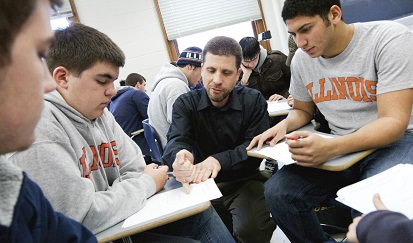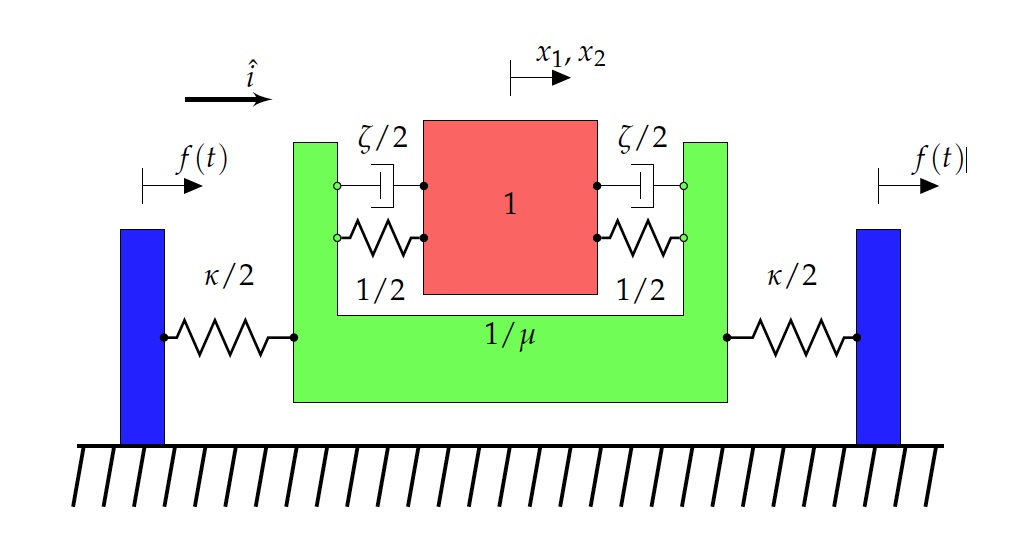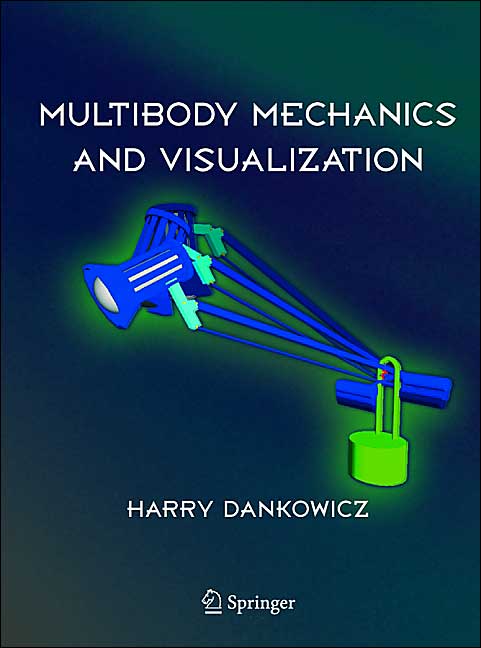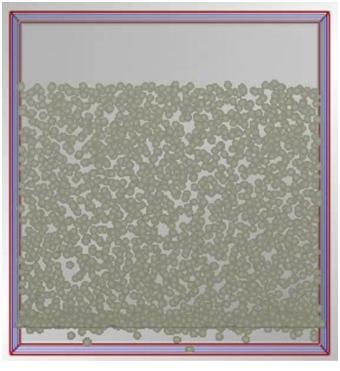Core Competence
 In the past decade, significant innovations were introduced in the introductory Physics, Calculus, and Mechanics sequences required of Grainger College of Engineering undergraduates. Increasingly, these rely on an emphasis on active and collaborative learning paradigms, context-driven instruction, and appropriate use of in-class or internet-based technology. These innovations enhance the student experience and aim to leave no student unsure of the purpose of the introductory classes in preparing for their subsequent education.
In the past decade, significant innovations were introduced in the introductory Physics, Calculus, and Mechanics sequences required of Grainger College of Engineering undergraduates. Increasingly, these rely on an emphasis on active and collaborative learning paradigms, context-driven instruction, and appropriate use of in-class or internet-based technology. These innovations enhance the student experience and aim to leave no student unsure of the purpose of the introductory classes in preparing for their subsequent education.
In my role as Calculus Project Coordinator for the College of Engineering between 2009 and 2011, I contributed to the development of a large number of active-learning worksheets inspired by problems from engineering, physics, and computation to contextualize Calculus I and II material for students from a variety of engineering curricula. In close collaboration with Mathematics faculty, I provided training to engineering and mathematics graduate student teaching assistants in the active-learning paradigm, and visited frequently with individual discussion sections to answer student questions. High on my list of priorities was to ensure that students would achieve a level of competence and appreciation for the course content and be ready to demand and expect further reinforcement of the course material in subsequent engineering classes. I found the students both receptive and appreciative of this advocacy on behalf of their education and on behalf of the topic that they had just worked so hard to command.
Read this article (.pdf, 93 kb) for more about the College of Engineering Calculus Project.
With grant support from the Academy for Excellence in Engineering Education in the Grainger College of Engineering, I initiated a curricular development effort called "Student Teaching Scholars – a model for just-in-time recertification of core engineering knowledge and skills," whose objectives were to instill a practice of life-long learning and skills recertification in our undergraduate student population, and to also provide meritorious opportunities for qualified undergraduates to receive education training and experience in leading recertification sessions as part of an Engineering Student Teaching Scholars program. During the 2012/13 and 2013/14 academic-years, this effort sought to:
- identify critical core concepts from the introductory calculus and linear algebra sequence that are targets of opportunity for recertification;
- develop pedagogically sound learning material for an accelerated recertification schedule;
- identify and develop a student-focused learning environment conducive to active and engaged recertification; and
- identify and invite potential Student Teaching Scholars and institute a recognized mechanism for rewarding their participation.
Project team: Harry Dankowicz and four undergraduate research assistants.
Flipped Instruction
 Since 2015, I have worked on implementing a flipped, learner-centered class environment for ME 340, Dynamics of Mechanical Systems, a junior-level required course in the undergraduate Mechanical Engineering curriculum. The teaching methodology and extensive resources that I have developed seek to implement recognized pedagogical principles that motivate students to engage intensely with course content, provide continuous feedback on progress, and ensure that students, teaching assistants, and instructor form a cohesive learning community. I have extensive observational evidence of such positive outcomes from versions of this model of instruction in course sections in Spring 2015, Summer 2015, Fall 2015, Summer 2016, Summer 2017, and Fall 2018.
Since 2015, I have worked on implementing a flipped, learner-centered class environment for ME 340, Dynamics of Mechanical Systems, a junior-level required course in the undergraduate Mechanical Engineering curriculum. The teaching methodology and extensive resources that I have developed seek to implement recognized pedagogical principles that motivate students to engage intensely with course content, provide continuous feedback on progress, and ensure that students, teaching assistants, and instructor form a cohesive learning community. I have extensive observational evidence of such positive outcomes from versions of this model of instruction in course sections in Spring 2015, Summer 2015, Fall 2015, Summer 2016, Summer 2017, and Fall 2018.
In the fully deployed flipped model, all instruction takes place through 14 online video pre-lectures and 36 online animated test review videos, while in-class sessions are devoted entirely to active-learning and team-based completion of 29 worksheets over the course of the semester. To realize this model, in addition to creating the video lectures and animations, I wrote a 210-page, fully-illustrated textbook that incorporates complete narrative scripts for the online pre-lectures, as well as complete solutions in narrative form for the worksheets. Each of the 11 chapters of the textbook also includes numerous fully solved exercises. A separate 60-page document contains a complete set of partially solved homework problems modeled on the exercises in the textbook. I also authored new pre-lab handouts that include comprehensive theoretical background for the content of each of the seven labs, including a set of solved exercises and pre-lab assignments modeled on the solved exercises. Finally, I developed a library of multiple-choice questions for seven formative assessments, used to generate fully randomized tests for paper or computer-assisted testing.
A guiding principle in this development, beyond ensuring a high level of engagement, has been the formulation of detailed learning objectives associated with each formative assessment. These objectives are available in text form and also emphasized throughout the animated test review videos. They highlight the path that the course takes through the subject and also ensure a high degree of synchrony with skills and knowledge developed and explored in the lab sections. Indeed, the logical sequencing of the lab assignments has been retained in the flow of the lecture notes, ensuring that students are adequately prepared and can appropriately integrate mathematical techniques and experimental observations.
This content development has resulted in a scalable model for course delivery that keeps students intensely engaged with the material during class and that gives me and the TAs opportunity to interact with almost every student, every single class hour. This is an experience that I have never been able to achieve in the standard teacher-centered paradigm, even when relying on various active-learning techniques to break up instruction, e.g., think-pair-share (TPS) or think-aloud-pair-problem-solving (TAPPS). I know the students by name within a few class meetings and develop a productive report that ensures they stay on target. Rarely is it even necessary to instruct the class to begin work as they quickly develop the right habits. The class environment is invigorating and truly enjoyable.
One interesting observation that I have learned to appreciate and integrate into the course design is that the control that an instructor experiences in a teacher-centered paradigm over the pace of delivery and “learning” is largely lost in the fully flipped model. Material that would take very little time to deliver by the instructor on the blackboard can take 20 minutes to work through by the students. This can be disconcerting to both instructor and students but must be embraced. To this end, I have introduced hints in the worksheets in places where experience has shown consistent confusion and also instruct the TAs to have patience and provide appropriate prompts if progress slows. Even as the pace of learning is thus determined by the students, and seven class meetings are used for assessments, I am able to cover all the learning objectives with time to spare at the end of the semester for extensive review.
In recognition of this course design and content development, I was awarded the Rose Award for Teaching Excellence in 2019 from the Grainger College of Engineering for excellence in undergraduate teaching and for motivating undergraduate students to learn and to appreciate engineering.
Read this web article for more about my experience with classroom instruction.
Project team: Harry Dankowicz with feedback from more than 100 undergraduate students.
Mechanics and Visualization
Undergraduate instruction into the subject of classical mechanics constitutes a first attempt at incorporating the mathematics taught in the undergraduate linear-algebra and calculus sequences with real-world applications, developing ideas of physical and mathematical modeling, assessing the relevance of physical phenomena, the appreciation of modeling assumptions, and the formulation of scientific inquiry. The field of multibody mechanics offers a natural environment in which to develop students’ skills in abstraction and model reduction. It allows the instructor to disassociate modeling assumptions regarding the purely geometric characteristics of a mechanism from assumptions regarding mass distribution and, the more challenging, assumptions regarding physical interactions with the environment.
 These observations have served as the impetus for the continuous development of course material and instructional resources for instruction in "Multibody Mechanics and Visualization." Various versions of this course were successfully implemented in the undergraduate curriculum for computer engineering and computer science sophomores at KTH Royal Institute of Technology in Sweden between 1999 and 2003; as an undergraduate engineering-science elective for electrical and computer-engineering juniors and seniors and as a graduate-level class at Virginia Polytechnic Institute and State University between 2000 and 2004; and as a technical elective for mechanical-engineering seniors and as a graduate-level dynamics class since 2006 at the University of Illinois at Urbana-Champaign.
These observations have served as the impetus for the continuous development of course material and instructional resources for instruction in "Multibody Mechanics and Visualization." Various versions of this course were successfully implemented in the undergraduate curriculum for computer engineering and computer science sophomores at KTH Royal Institute of Technology in Sweden between 1999 and 2003; as an undergraduate engineering-science elective for electrical and computer-engineering juniors and seniors and as a graduate-level class at Virginia Polytechnic Institute and State University between 2000 and 2004; and as a technical elective for mechanical-engineering seniors and as a graduate-level dynamics class since 2006 at the University of Illinois at Urbana-Champaign.
In recognition of this course design and content development, I was awarded the W.S. 'Pete' White Innovation in Engineering Education Award in 2004 from Virginia Tech and the Collins Award for Innovative Teaching in 2012 from the College of Engineering at UIUC.
Read this article (.pdf, 102 kb) for more about this curricular effort.
Examples of innovative courseware developed for this course are MAMBO and the MAMBO toolbox, described on the MAMBO website as well as the textbook Multibody Mechanics and Visualization, published by Springer-Verlag, UK, in 2004.
Project team: Harry Dankowicz, Arne Nordmark, Jesper Adolfsson, Kalle Andersson, Justin Hutchison, Gabriel Ortiz, Anders Lennartsson, Petri Piiroinen.
Responsible Conduct
The responsible conduct of research (RCR) relies on a careful assessment of standards of good practice and ethics that serve to maintain broad-based trust and reliance on the scientific method in the search for testable explanations of natural phenomena, in the application to design and problem solving, and in the service of formulating policy recommendations.
 Model development is that act of scientific authorship in which salient features of an observable phenomenon are reduced to an accessible formulation that enables the testing of scientific hypotheses in a rigorous and effective manner. The classical engineering sciences have used mathematical models, e.g., systems of differential equations, that reflect essential properties of a physical system and whose solution describes the system behavior. In the past thirty years, a new class of model development has become feasible, namely, the synthesis of computational models that produce quantitative information about the behavior of complex systems. Computation extends the analyst's ability to understand he behavior of simple mathematical models for which closed-form solutions are not available. More importantly, computational modeling and research is now a sub-discipline of existing engineering and science fields. In many cases, researchers can bypass the formulation of a mathematical model and instead reduce system behavior directly to computational algorithms.
Model development is that act of scientific authorship in which salient features of an observable phenomenon are reduced to an accessible formulation that enables the testing of scientific hypotheses in a rigorous and effective manner. The classical engineering sciences have used mathematical models, e.g., systems of differential equations, that reflect essential properties of a physical system and whose solution describes the system behavior. In the past thirty years, a new class of model development has become feasible, namely, the synthesis of computational models that produce quantitative information about the behavior of complex systems. Computation extends the analyst's ability to understand he behavior of simple mathematical models for which closed-form solutions are not available. More importantly, computational modeling and research is now a sub-discipline of existing engineering and science fields. In many cases, researchers can bypass the formulation of a mathematical model and instead reduce system behavior directly to computational algorithms.
With support from the National Science Foundation program for Ethics Education in Science and Engineering, I was engaged in the curricular development and research effort The Responsible Conduct of Computational Modeling and Research, whose objectives were to
- identify and examine the ethical issues and accepted professional standards for responsible conduct of computational modeling and research, particularly those not shared with experimental research.
- identify and examine standards of good practice in evaluating model integrity, model robustness, model representations, data and code integrity, and intellectual property rights.
- develop graduate-level instructional materials to engage students in domain-generic, disciplined reasoning about ethical problems and standards specific to computational modeling and research, e.g., through case studies and associated commentaries.
- assess the quality and educational effectiveness of the instructional materials with graduate students and instructors at two or more universities.
- disseminate the instructional materials through demonstrations at conferences, publications in journals, and archiving at the Online Ethics Center of the National Academy of Engineering.
These project objectives constituted an integrated effort aimed at empirically establishing accepted standards of practice in computational modeling and research, and enabling the deployment of education modules on related issues of responsible conduct of research throughout graduate programs in engineering and science.
A deliverable of this project, the package "Responsible Conduct in Computational Modeling and Research" (.pdf, 1.86 Mb) contains resources for academic instruction and professional training in the responsible conduct of computational modeling and research, providing the reader with a framework within which to establish the integrity and trustworthiness of computational representations and their predictions. The package discusses learning objectives and pedagogical approaches, and provides tools appropriate for use in instruction, for example, fictional case studies, scoring guides, and check lists.
See the project website for additional information about the project and associated publications.
Project team: Michael Loui, Harry Dankowicz, Sara Wilson, Matthew Keefer, David Kijowski, Christian Day, Nicole Cooley, Ying Liu, Harshi Manamendra

